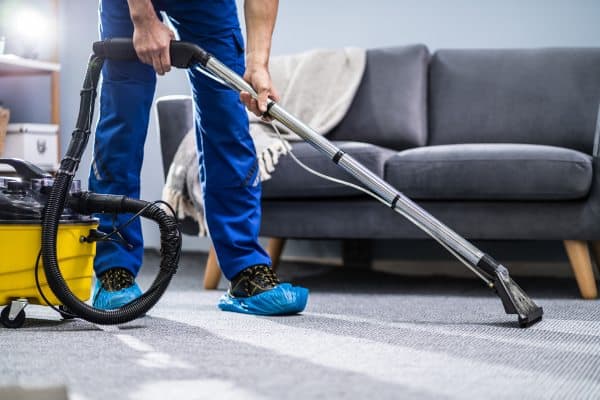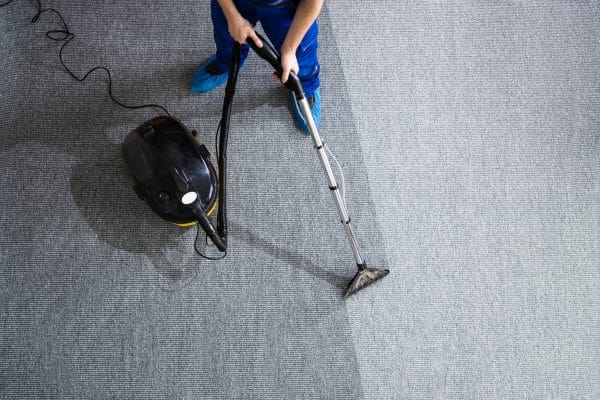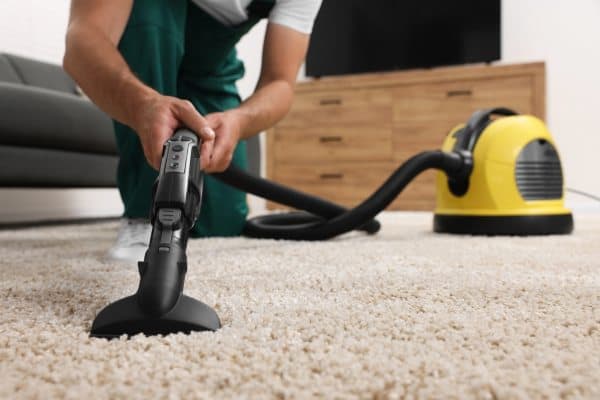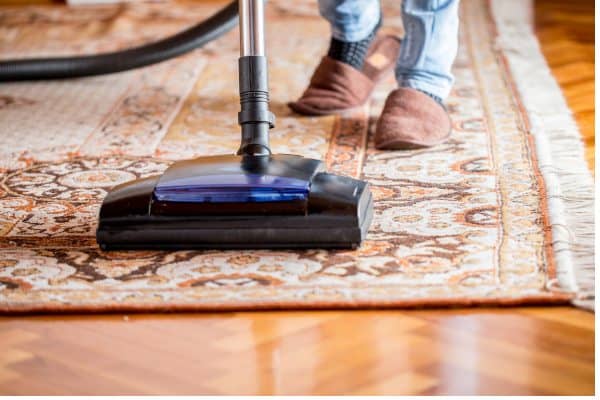Your rug’s seen it all—bare feet, dirty shoes, rogue popcorn kernels, pet hair tumbleweeds, and that one unforgettable coffee spill. It quietly puts up with life’s messiest moments, but behind the scenes? It’s hoarding more dirt than you’d think.
According to the EPA, rugs and carpets can hold up to four times their weight in dirt. That’s not just gross—it’s a hidden hygiene problem. From dust mites to pet dander, what’s underfoot might be messing with your air quality and allergies.
Now, we’re not knocking professional cleaning (sometimes it’s a must), but not every smudge or mystery stain needs a service call. The truth is, you can clean a rug at home without wrecking the fibers—or your weekend plans.
Ahead, we’ll break down 7 smart, no-fuss ways to safely clean rugs of all kinds. Grab a soft brush and a little motivation—your rug’s glow-up starts now.
What You Should Know Before Cleaning Your Rug

Before you grab the sponge and declare war on that mysterious rug stain, pause for a second—your rug might have more opinions about cleaning than you think.
Start with the material. Wool rugs, synthetic fibers, cotton, jute, even silk—they each have their own quirks.
For example, synthetic rugs can usually handle a thorough cleaning process with a gentle detergent and a soft bristle brush. On the other hand, natural fiber rugs like jute or sisal don’t love moisture and can warp or discolor if treated like a standard area rug.
When in doubt, flip it over and check the care label—if it’s still attached. That tiny tag can tell you whether your rug is safe for machine washing, hand washing, spot cleaning, or if it’s better left to the pros.
No care label? Go slow. Hand-washing with a mild detergent is usually the safest bet for unknown or delicate materials, but if you’re dealing with an antique rug or something sentimental, a professional cleaning service is worth considering.
Before you douse your rug in any cleaning solution—DIY or store-bought—test it.
Always. Pick a small, hidden corner and do a spot test to see how the rug responds. This step is especially important when working with vibrant oriental rugs or anything with dyes that might not be colorfast. You don’t want your deep cleaning turning into a dye disaster.
Another step rug owners tend to overlook? Pre-cleaning prep.
Before you apply water or a cleaning solution, shake out loose dirt or give the rug a solid once-over with a vacuum cleaner. Use the upholstery attachment or a vacuum with the beater bar turned off to avoid damaging delicate rug fibers.
Removing surface-level crumbs, pet hair, and dust mites first helps the cleaning process work more effectively and prevents you from rubbing grime deeper into the fibers.
Getting your rug ready is half the job. Do it right, and the actual cleaning becomes much easier—and way more effective.
7 Effective Methods to Clean a Rug at Home
1. Vacuuming: The First Step to Every Clean Rug

Your rug may not scream for help, but trust us—it’s collecting secrets in the form of dust, dirt, and pet hair. If you haven’t vacuumed it in a while, it’s probably holding onto more grime than your doormat.
Before you break out the heavy-duty cleaning gear, start with the basics: vacuuming. And no, a quick once-over won’t cut it.
Flip that area rug over and vacuum both sides. The underside traps just as much debris—sometimes more. For the best results, switch your vacuum to the carpet setting or use one designed specifically for rugs and carpets.
If your vacuum has a brush roll or beater bar, even better. These attachments lift embedded dirt from the rug’s fibers.
But if you’re working with delicate materials like silk, shag, or antique rugs, skip the beater bar and go with a soft brush attachment or simply vacuum with care to avoid damage.
Here’s the dirty truth: rugs in high-traffic zones can gather up to one pound of dirt per square foot every year. That’s reason enough to make vacuuming a weekly ritual—and even more often in busy spots like hallways, entryways, or under the dining table.
Vacuuming sets the stage for a thorough cleaning process. Get it right, and every method that follows becomes more effective. Ready for the next step? Let’s move beyond the vacuum.
2. Baking Soda and Vinegar Method
If your rug smells more like last week’s takeout than fresh linen, it’s time to bring in the big guns—straight from your kitchen.
Baking soda and vinegar might sound like ingredients for a science fair volcano, but together, they’re a powerhouse for neutralizing odors and tackling mild stains. Using vinegar for cleaning is a natural, chemical-free way to refresh rugs at home.
This method is a go-to for rug owners who want a more natural, chemical-free way to clean rugs at home.
Baking soda helps lift dirt and freshen up the rug’s fibers, while vinegar acts as a mild disinfectant that breaks down stubborn grime—perfect for pet stains or that weird musty smell no one wants to talk about.
Here’s how to do it: generously sprinkle baking soda over the entire rug.
Next, grab a spray bottle and mix equal parts white vinegar and water. Lightly mist the rug until the fizzing begins—that’s the magic in action. Let it sit for 10 to 15 minutes to work its way into the fibers.
After the bubbling show’s over, blot any excess liquid with a clean cloth or paper towel, then vacuum up what’s left once it dries. And before you go full DIY chemist mode on your large rug, always test this solution on a small, hidden spot.
Not all rugs—especially natural fiber or antique rugs—play nice with vinegar.
Now that your rug smells like a breath of fresh air, let’s move on to a method made for deeper cleaning.
3. Dish Soap and Warm Water Solution
Caught a spill in action? Don’t panic—just move fast. That mysterious sauce blob on your area rug might look like a permanent guest, but with the right approach, it doesn’t stand a chance.
Start by blotting—don’t rub—the mess with a paper towel or clean cloth. The goal here is to lift as much excess water or liquid as possible without grinding it deeper into the rug fibers. Think dabbing, not scrubbing.
Now for the cleanup crew: grab a bucket, add some warm (not hot) water, and mix in a few drops of mild dish soap. It’s a gentle but effective combo, especially for synthetic rugs or cotton materials. Dip a soft-bristle brush or sponge into the solution and gently scrub the rug in small sections.
This gives you more control and helps avoid over-saturating the rug.
Once the stain is gone and you’ve cleaned the entire rug, rinse the area with a damp cloth to remove any leftover soap. Then lay the rug flat and let it air dry completely—bonus points if you can place it in a spot with sunlight.
This method is budget-friendly, easy, and super effective for everyday messes. Just keep it away from wool rugs and delicate materials—those need a gentler touch (or a different method, coming up next).
4. Steam Cleaning (If You Have a Machine)
If your rug’s holding onto more secrets than your group chat, it’s probably overdue for a serious clean—and steam is your undercover hero.
Unlike traditional methods that leave rugs soaked and sulking, steam cleaning dives deep with heat and just enough moisture to lift out the grime without creating a puddle in your living room.
Think of steam cleaning as the spa day your rug never knew it needed. It tackles embedded dirt, bacteria, and allergens with high heat and minimal moisture—ideal for thick, dense rugs that need more than surface-level cleaning.
In fact, when done correctly, steam cleaning can eliminate up to 99.9% of bacteria and allergens, making it a favorite for allergy-prone households.
Before you fire up the machine, prep the rug like a pro. Start by vacuuming thoroughly to pick up loose dirt and pet hair. If there are visible stains, treat them first using a rug-safe pretreat spray and let it sit for about five minutes.
Next, fill your steam cleaner with warm water and rug-friendly detergent, then slowly glide it across the rug in a steady back-and-forth motion. Press the trigger to release the steam as you move, allowing it to sink deep into the rug fibers. Go slow—it’s not a race.
Once you’re done, resist the urge to walk on it right away. Let the rug air dry completely, either outdoors or near fans, to prevent musty odors and ensure all moisture evaporates.
5. Hydrogen Peroxide for Stubborn Stains
Some stains are just plain rude. They show up uninvited—wine, blood, ink, mystery pet disasters—and refuse to leave quietly.
When blotting and scrubbing doesn’t cut it, it’s time to call in a quiet little powerhouse: hydrogen peroxide.
This isn’t your average cleaning hack.
Hydrogen peroxide (3%) has oxidizing properties that break down tough stains at the molecular level. It’s like sending in a microscopic cleanup crew with a no-nonsense attitude.
Just mix equal parts hydrogen peroxide and water in a spray bottle, and you’ve got yourself a potent DIY stain remover—no store-bought cleaner needed.
Spray the solution directly on the target stains (think red wine on a beige area rug or coffee drips from a rushed morning). Let it sit for about 10 minutes so it can work its magic, then blot with a clean microfiber cloth. Repeat if necessary until the stain gives up.
One caveat: hydrogen peroxide has mild bleaching properties, so it’s not a fit for colored or delicate rugs like wool or natural fiber rugs. Always test on an inconspicuous area first to avoid accidental fading.
This trick is perfect for rug owners who want to safely clean without adding harsh chemicals into the mix.
6. Dry Carpet Cleaner Powder

Not all rugs play well with water. Some are drama queens—looking at you, wool and jute—that shrink, warp, or throw a fit at the first drop of moisture.
For these moisture-sensitive types, dry carpet cleaner powder is the low-stress, no-mess solution.
Think of it as dry shampoo, but for your rug. When you don’t have time (or permission) to get it wet, sprinkle a generous layer of commercial dry cleaning powder evenly across the rug’s surface.
Then, gently work it in using a soft brush or even a broom with soft bristles—just enough to help it settle into the fibers and absorb odors, oils, and dirt.
Let it sit for 30 to 60 minutes while it does its behind-the-scenes magic. After that, vacuum thoroughly to remove the powder along with all the gunk it pulled out.
This method is perfect for quick refreshes, spot cleaning, or maintaining antique rugs and natural fibers that need a gentler touch.
7. Snow Cleaning (Winter-Only, Old-School Trick!)
Who knew your rug could enjoy snow days too? While you’re bundled up inside sipping hot cocoa, your rug could be outside getting a deep clean the old-fashioned way—no water, no detergent, just fresh powder and a little muscle.
Snow cleaning may sound bizarre, but it’s a time-tested tradition in snowy regions, especially for thick, woven rugs that need a thorough yet gentle refresh. The trick is using clean, dry snow—not slush, not ice—to pull out dust and dirt without soaking the rug.
Here’s how it works: take the rug outdoors and lay it upside down on a fresh patch of snow. Then, using a broomstick or rug beater, give the back a solid workout. As you hit the rug, dirt and debris shake loose and transfer into the snow below.
It’s oddly satisfying—and effective.
Once you’re done, flip the rug over, brush off any remaining snow, and bring it inside to air dry completely. It’s a chemical-free method that’s gentle on the rug’s fibers and great for antique or natural fiber rugs that can’t handle moisture or aggressive cleaners.
It may be seasonal, but when the flakes fall, this cleaning hack is as cool as it gets—literally. Ready to wrap things up? Let’s bring it all together.
A Clean Rug Starts with Consistent Care

So, what’s the secret to a fresher, fluffier, longer-lasting rug? Spoiler alert: it’s not some fancy gadget or mystery spray—it’s you. Once you know how to clean a rug at home using simple techniques and a bit of consistency, those dingy spots and mystery odors don’t stand a chance.
The truth is, rugs don’t need dramatic interventions. They just want regular attention—some weekly vacuuming, the occasional deep scrub, and a quick save when life throws a spill their way. Keep that up, and your rug will repay you with years of softness underfoot and fewer allergy flare-ups.
From tough synthetics to delicate natural fibers, each rug has its own personality—and now, you’ve got the cleaning method to match. Whether you’re going full steam or keeping it old-school with baking soda and vinegar, the tools are right at home (literally).
Your floors will thank you, your guests will notice, and your feet? They’ll never want to leave.
FAQs
Can I use Dawn dish soap to clean a rug?
Yes, you can safely clean a rug at home using mild dish soap like Dawn—especially on synthetic rugs or cotton materials. Mix a few drops with warm water and gently scrub with a soft bristle brush or sponge. Just be sure to avoid oversaturating the rug, rinse thoroughly with a damp cloth, and air dry completely. While this method works well for everyday messes, avoid it on wool rugs or delicate fibers, and always test on an inconspicuous area first to prevent discoloration.
Can I clean a rug with soap and water?
Cleaning a rug with soap and water is totally doable—but it depends on the rug’s material. Synthetic fibers and cotton rugs usually handle this combo well, especially with a gentle detergent or mild dish soap. Use warm water, scrub gently with a soft brush, and avoid soaking the rug. Rinse lightly and let the rug air dry completely. Delicate materials like wool, silk, or natural fiber rugs might not react well to water, so spot testing and checking the rug’s care label is always a smart move.
What is the best thing to wash a rug with?
The best thing to wash a rug with depends on what you’re cleaning and what the rug is made of. For general cleaning, a mix of mild detergent and warm water works well on synthetic rugs. Baking soda and white vinegar are perfect for neutralizing pet stains and odors naturally. If you’re dealing with stubborn stains like wine or ink, hydrogen peroxide can help—just avoid it on colored or antique rug fibers. Always consider the rug’s material and test any cleaning solution on a small, hidden area before tackling the entire rug.
Can you hose down a rug to clean it?
Yes, you can hose down a rug—especially large rugs made from synthetic materials or outdoor rugs designed to handle moisture. Lay the rug flat outside, ideally on a clean surface, and use a garden hose with medium pressure to rinse away dirt and loosen debris. For a deeper clean, scrub with a soft brush and mild detergent before rinsing. Just make sure to remove as much excess water as possible and let the rug air dry completely in sunlight to avoid mildew. Avoid hosing down delicate or natural fiber rugs—they’re better off with dry or spot cleaning methods.

